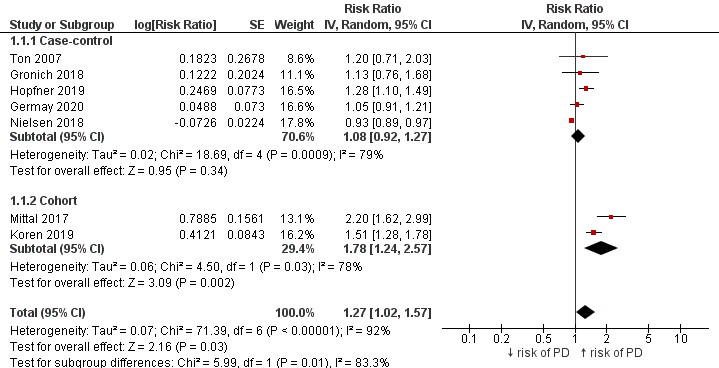Objective: We performed a systematic review and meta-analysis of real-world evidence (RWE) studies evaluating the association between use of β-antagonist and the risk of PD.
Background: Parkinson’s disease (PD) is exhibited by intracellular accumulation of Lewy Bodies (α-synuclein) encoded by α-synuclein gene. A possible relationship between β-adrenergics and α-synuclein synthesis has been shown. RWE studies evaluating β-antagonist use and risk of PD have reported conflicting findings.
Method: PubMed and Embase were searched from inception to October 2020 using Ovid. Two reviewers screened records in duplicate and RWE studies reporting the relative risk (RR) estimates of PD in β-antagonist users, compared to non-users, were included. Newcastle-Ottawa scales (NOS) was used to assess the study quality. We employed the generic inverse variance method using RevMan (5.3.5) to estimate pooled adjusted RR (aRR) using a random-effects model. Sub-groups were analyzed based on study design and type of β-antagonist used.
Results: Of 1054 records, 8 studies (2 cohort, 6 case-control) with 6267037 participants, including 74189 PD cases, were included. A significant heterogeneity (I2>92%) was observed and majority (n=7) of the studies were of moderate to high quality, based on NOS. In the overall pooled analysis (studies, n=7) including any β-antagonist users, compared with non-users, the aRR for PD was 1.27 (CI:1.02,1.57;P= 0.03) (Fig 1). The risk of PD, in β-antagonist users, compared to non-users, was significant for cohort studies (n= 2) (aRR:1.78;CI:1.24,2.57;P=0.002), and non-significant (aRR:1.08;CI:0.92,1.27;P=0.34) for the case-control studies (n= 5). By β-antagonist type, risk of PD was significantly higher only for the propranolol (aRR:1.91;CI:1.20,3.06;P=0.007) (Fig 2) and not for metoprolol (aRR:1.05;CI:0.88,1.24;P=0.61), carvedilol (aRR:0.87;CI:0.79,0.96;P=0.006), bisoprolol (aRR:0.93;CI:0.60,1.43;P=0.73), sotalol (aRR:1.03;CI:0.69,1.52;P=0.90), and atenolol (aRR:0.97;CI:0.92,1.02;P=0.28) users, compared to non-users.
Conclusion: In the overall analysis, including any β-antagonist use, an increased risk of PD was observed compared to β-antagonist non-users. The increased risk of PD was driven mainly by propranolol use and not the other β-antagonists’ use, possibly indicating a protopathic bias.
To cite this abstract in AMA style:
A. Singh, S. Hussain, B. Antony. Beta-antagonists and risk of Parkinson’s disease: Meta-analysis of real-world evidence studies [abstract]. Mov Disord. 2021; 36 (suppl 1). https://www.mdsabstracts.org/abstract/beta-antagonists-and-risk-of-parkinsons-disease-meta-analysis-of-real-world-evidence-studies/. Accessed April 22, 2025.« Back to MDS Virtual Congress 2021
MDS Abstracts - https://www.mdsabstracts.org/abstract/beta-antagonists-and-risk-of-parkinsons-disease-meta-analysis-of-real-world-evidence-studies/


